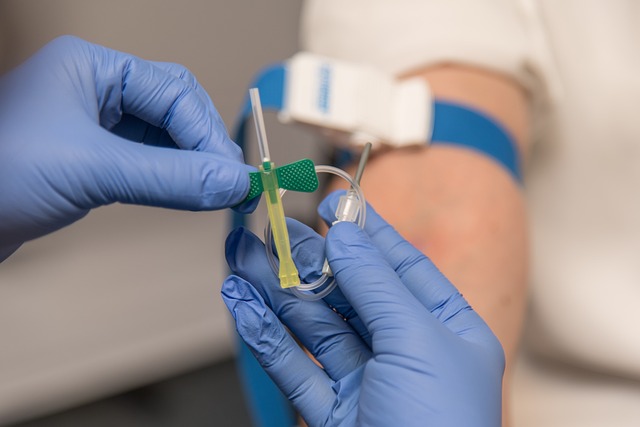Iron deficiency anemia, common in the UK, affects oxygen transport due to low iron levels. Symptoms vary widely but include fatigue, weakness, and dizziness. Early detection through regular UK Standard Thyroid Blood Tests (STBT) is crucial, as untreated anemia can lead to serious health issues. The STBT measures hemoglobin, red blood cells, and ferritin to diagnose iron deficiency by low ferritin levels, guiding effective treatment. This comprehensive test assesses thyroid function and detects issues like hypothyroidism or hyperthyroidism, playing a vital role in overall health evaluation.
Iron deficiency anemia is a common yet serious condition, often caused by inadequate iron intake or blood loss. Understanding its subtle symptoms is key to early detection. This article delves into the diagnostic process, emphasizing the role of blood tests as essential tools for identifying iron deficiency anemia. We explore how these tests, including the UK Standard Thyroid Blood Test, help healthcare professionals make accurate diagnoses and recommend appropriate treatments.
- Understanding Iron Deficiency Anemia and its Symptoms
- The Role of Blood Tests in Diagnosing Iron Deficiency Anemia
- UK Standard Thyroid Blood Test: What You Need to Know
Understanding Iron Deficiency Anemia and its Symptoms
Iron deficiency anemia is a common blood disorder where the body lacks enough healthy red blood cells, often due to low iron levels. Iron plays a crucial role in carrying oxygen throughout our bodies, so when there’s a deficiency, it can lead to various symptoms. Understanding these signs is essential as they can vary from person to person but may include fatigue, weakness, pale skin, shortness of breath, dizziness, and headaches. Those with anemia might also experience difficulty concentrating or have cold hands and feet. In the UK, a standard thyroid blood test often includes measurements that can help identify anemia; it’s a simple way to screen for this condition and ensure prompt treatment if necessary.
The symptoms mentioned above can be easily overlooked, especially as they may not always be severe. However, left untreated, iron deficiency anemia can have more serious consequences over time. It’s important to remember that early detection through regular blood tests is key; these tests, such as the UK Standard Thyroid Blood Test, can help healthcare professionals make a diagnosis and recommend suitable treatment options.
The Role of Blood Tests in Diagnosing Iron Deficiency Anemia
In diagnosing iron deficiency anemia, blood tests play a pivotal role by providing crucial insights into an individual’s overall health and nutritional status. One common and essential test in the UK is the Standard Thyroid Blood Test (STBT), which goes beyond assessing thyroid function to offer valuable data on iron levels. This comprehensive test measures various parameters, including hemoglobin (Hb) concentration, red blood cell count, and ferritin levels—all of which are indicators of iron status.
By analyzing these markers, healthcare professionals can accurately identify iron deficiency anemia. Low levels of ferritin, for instance, suggest that the body may not have enough stored iron, a common characteristic of this type of anemia. The STBT is instrumental in confirming diagnosis and guiding treatment decisions, ensuring individuals receive appropriate interventions to manage their iron levels effectively.
UK Standard Thyroid Blood Test: What You Need to Know
In the UK, the UK Standard Thyroid Blood Test is a crucial diagnostic tool for evaluating thyroid function and identifying potential issues, including iron deficiency anemia. This comprehensive test measures key hormones and provides insights into overall thyroid health. Typically, it involves analyzing blood samples to check for levels of thyroid-stimulating hormone (TSH), thyroxine (T4), and triiodothyronine (T3). These hormones play a pivotal role in regulating metabolism and energy production in the body.
The test is designed to detect abnormalities that may indicate underactive (hypothyroidism) or overactive (hyperthyroidism) thyroid conditions. It’s important to note that iron deficiency anemia itself doesn’t directly impact thyroid hormone levels, but underlying causes like malnutrition or chronic bleeding can affect both thyroid function and red blood cell health. Therefore, this test is often part of a broader evaluation when diagnosing and managing anemia, ensuring a holistic understanding of an individual’s health.
Iron deficiency anemia is a common yet treatable condition, and blood tests play a pivotal role in its diagnosis. The UK Standard Thyroid Blood Test is a crucial tool that helps healthcare professionals identify iron deficiency anemia by assessing the levels of key nutrients and hormones related to thyroid function. Understanding both the symptoms and diagnostic methods, such as this specific blood test, enables individuals to seek timely treatment and alleviate the associated health risks.
